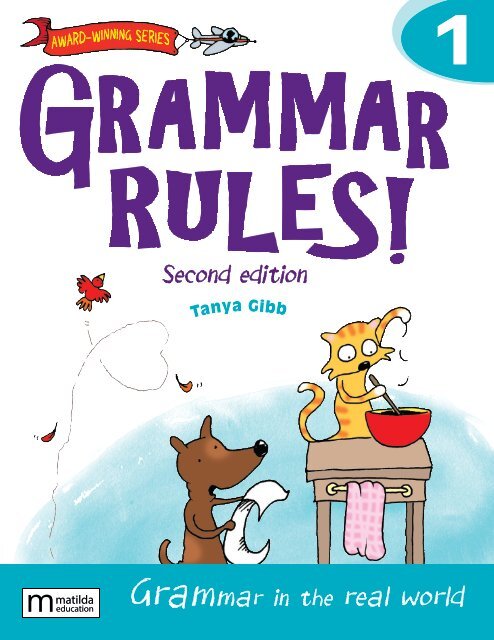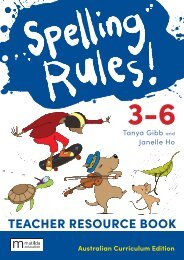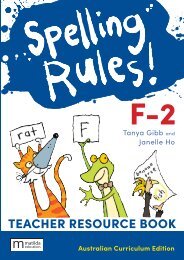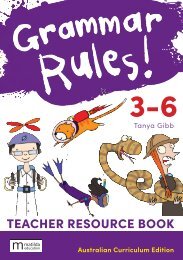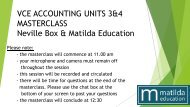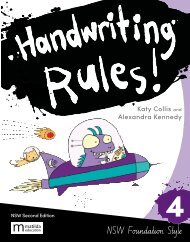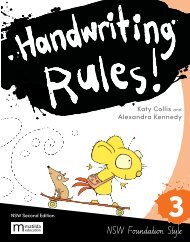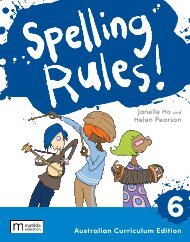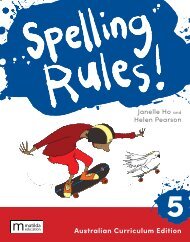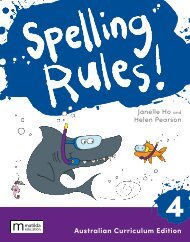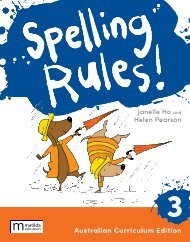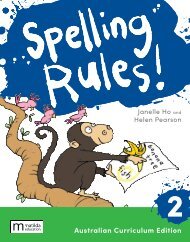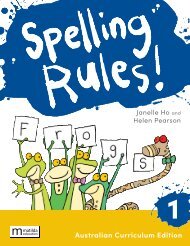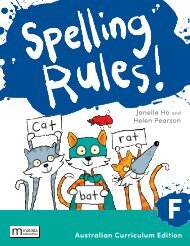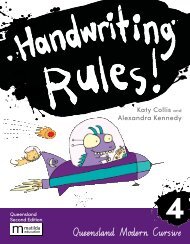Create successful ePaper yourself
Turn your PDF publications into a flip-book with our unique Google optimized e-Paper software.
AWARD- D-WINNI NNING SERIES<br />
1<br />
Second edition<br />
Tanya Gibb<br />
<strong>Grammar</strong> in the real world
Contents<br />
Note to Teachers and Parents....................................... 2<br />
Scope and Sequence...................................................... 4<br />
Units 1–35..................................................................... 6<br />
<strong>Grammar</strong> <strong>Rules</strong> – a glossary and index....................... 76<br />
Writing Log...................................centre pull-out pages<br />
This edition published in 2021 by<br />
Matilda Education Australia, an imprint<br />
of Meanwhile Education Pty Ltd<br />
Level 1/274 Brunswick St<br />
Fitzroy, Victoria Australia 3065<br />
T: 1300 277 235<br />
E: customersupport@matildaed.com.au<br />
www.matildaeducation.com.au<br />
First edition published in 2008 by Macmillan Science and Education Australia Pty Ltd<br />
Copyright © Tanya Gibb/Macmillan Education Australia 2016<br />
All rights reserved.<br />
Except under the conditions described in the Copyright Act 1968 of Australia and subsequent<br />
amendments, no part of this publication may be reproduced, stored in a retrieval system, or transmitted<br />
in any form or by any means, electronic, mechanical, photocopying, recording or otherwise, without the<br />
prior written permission of the copyright owner.<br />
Educational institutions copying any part of this <strong>book</strong> for educational purposes under the Act must be<br />
covered by a Copyright Agency Limited (CAL) licence for educational institutions and must have given a<br />
remuneration notice to CAL. Licence restrictions must be adhered to. Any copies must be photocopies<br />
only, and they must not be hired out or sold. For details of the CAL licence contact: Copyright Agency<br />
Limited, Level 11, 66 Goulburn Street, Sydney, NSW 2000. Telephone: (02) 9394 7600.<br />
Facsimile: (02) 9394 7601. Email: info@copyright.com.au<br />
Publisher: First edition Sharon Dalgleish<br />
Designers: Trish Hayes and Stephen Michael King<br />
Illustrator: Stephen Michael King<br />
Printed in Singapore by Markono Print Media Pte Ltd<br />
1 2 3 4 5 6 7 25 24 23 22 21 20.<br />
Supports the English curriculum<br />
Student Book Foundation 1 2 3 4 5 6<br />
Australian Curriculum F 1 2 3 4 5 6<br />
NSW Syllabus Early Stage 1 Stage 1 Stage 2 Stage 3<br />
New Zealand Curriculum 1 2 3 4 5 6 7
Note to Teachers Note and to teachers Parents and parents<br />
<strong>Grammar</strong> <strong>Rules</strong>!<br />
A whole-school grammar program that teaches grammar in context!<br />
<strong>Grammar</strong> <strong>Rules</strong>! comprehensively meets the requirements of the Australian Curriculum English. The scope and sequence<br />
outlined on pages 4–5 integrates Language, Literature and Literacy to develop <strong>student</strong>s’ knowledge, understanding and<br />
skills in listening, reading, viewing, speaking and representing.<br />
<strong>Grammar</strong> <strong>Rules</strong>! also supports the New Zealand English Curriculum strands: Listening, Reading and Viewing; and Speaking,<br />
Writing and Presenting. Students will use processes and strategies to develop knowledge, skills and understandings,<br />
related to purposes and audiences, ideas, language features and structure.<br />
<strong>Grammar</strong> can be defined as the way language is organised to make meaning. Knowledge of the grammatical features that<br />
make language use more effective is vital for all <strong>student</strong>s. They need an understanding of grammar to be able to make<br />
appropriate choices to get their message across in speaking and writing (creating texts); and they need to know how to<br />
analyse the language used by others when they are listening and reading (interpreting texts). Grammatical knowledge will<br />
assist <strong>student</strong>s to become analytical, critical and evaluative language users.<br />
<strong>Grammar</strong> <strong>Rules</strong>! shows <strong>student</strong>s how grammatical structures and features function in texts to achieve meaning, from the<br />
contextual level of the whole text down to sentence level and to the level of words and word parts. The series explains<br />
appropriate grammatical structures for particular types of texts, language functions and social purposes. The second edition<br />
of the <strong>Grammar</strong> <strong>Rules</strong>! program also incorporates elements of self-assessment. A simple reflection activity allows <strong>student</strong>s to<br />
assess their own progress and provides you with a starting point for discussion.<br />
Student Book 1<br />
Units of work<br />
Student Book 1 contains 35 weekly units of work presented in a conceptually sound scope and sequence. The intention<br />
is for <strong>student</strong>s to work through the units in the sequence in which they are presented. See the Scope and Sequence<br />
Chart on pages 4–5 for more information. There are also regular Revision Units that can be used for consolidation or<br />
assessment purposes.<br />
The <strong>sample</strong> texts in Student Book 1 are not tied to any particular content across other curriculum areas. This allows<br />
teachers and <strong>student</strong>s to focus on the way language is structured in the different types of texts according to purpose<br />
and audience. Students can then use this knowledge to critically evaluate, respond to and create texts in other learning<br />
areas. The concepts dealt with in the <strong>sample</strong> texts link well with the Cross-Curriculum Priority of Sustainability, as well<br />
the General Capabilities of Critical and Creative Thinking, Personal and Social Capability, Ethical Understanding and<br />
Intercultural Understanding, as described in the Australian Curriculum.<br />
Icons<br />
Try it<br />
yourself!<br />
Encourages <strong>student</strong>s to create texts of their own to demonstrate their understanding of the<br />
grammatical concepts taught in the unit. These activities focus on written language; however, many<br />
also provide opportunities for using spoken language to engage with others, make presentations and<br />
develop skills in using ICT.<br />
Rule!<br />
Tip!<br />
Highlights useful grammatical rules and concepts.<br />
The rule is always introduced the first time <strong>student</strong>s<br />
need it to complete an activity.<br />
Tells <strong>student</strong>s that a special hint is provided for an<br />
activity. It might be a tip about language functions,<br />
or a reminder to <strong>look</strong> at a rule in a previous unit.<br />
Reflection<br />
I can do this.<br />
I am not sure.<br />
I need help.<br />
Allows <strong>student</strong>s to assess their<br />
progress across each unit.<br />
<strong>Grammar</strong> <strong>Rules</strong> Glossary<br />
A valuable glossary is provided at the end of Student Book 1. Teachers and <strong>student</strong>s can use this as a straightforward<br />
dictionary of grammar terminology, or as a summary of important grammar rules used in Student Book 1. Page references<br />
are also given for the point in the <strong>book</strong> where the rule was first introduced, so that <strong>student</strong>s can go back to that unit if<br />
they need more information or further revision of the rule.<br />
2
<strong>Grammar</strong> <strong>Rules</strong>! Student Book 1 (ISBN 9781420236576) © Tanya Gibb/Macmillan Education Australia<br />
<strong>Grammar</strong> <strong>Rules</strong>! Student Book 1 (ISBN 9781420236576) © Tanya Gibb/Macmillan Education Australia<br />
© Tanya Gibb/Macmillan Education Australia 2016<br />
Pull-Out Writing Log<br />
At the centre of Student Book 1 is a practical pull-out Writing Log so that <strong>student</strong>s can directly relate the grammar they<br />
learn back to their own writing. Students could store the Writing Log in their writing folders, and use it to keep track<br />
of the grammar, language functions and types of texts they use. The Writing Log also includes a handy reminder of the<br />
writing process, as well as a checklist of types of texts for <strong>student</strong>s to try.<br />
I Think<br />
What is your topic?<br />
What is the purpose of the<br />
writing?<br />
Who is the audience?<br />
What type of text and text<br />
form will you use?<br />
3<br />
Revise<br />
<strong>Grammar</strong> <strong>Rules</strong>!<br />
Read your writing to a partner.<br />
Read your writing to your<br />
teacher.<br />
Ask for help to improve your<br />
writing.<br />
's Writing Log<br />
2<br />
Draft<br />
Gather your ideas.<br />
Have a go at writing.<br />
4 Proofread<br />
Check your grammar.<br />
Check your spelling.<br />
Check your punctuation.<br />
5 Publish<br />
Publish your writing.<br />
Share your writing.<br />
Reflect on your writing.<br />
Each time you<br />
finish a piece<br />
of writing,<br />
record it in<br />
the log. Give<br />
it a rating.<br />
Rating scale<br />
A good start.<br />
Doing well.<br />
Brilliant!<br />
Do you need<br />
some ideas for<br />
other text forms<br />
to try? Look at<br />
the back page!<br />
Date<br />
Write the<br />
date.<br />
Title<br />
Write the title of your<br />
piece.<br />
Type of text<br />
Audience <strong>Grammar</strong> I used My rating Where to next?<br />
and text form<br />
eg recount/ Who were you List the main grammar features you used. Record your What would you like to try next?<br />
letter writing for or to?<br />
rating.<br />
Does your teacher have any comments?<br />
I've tried these types of texts and text forms . . .<br />
Narrative (imaginative) Explanation (informative)<br />
Story<br />
Comic<br />
Other<br />
Recount<br />
(imaginative or informative)<br />
Letter<br />
Other<br />
Description<br />
(imaginative or informative)<br />
Poem<br />
Letter<br />
Other<br />
Information report<br />
(informative)<br />
Website<br />
Other<br />
Procedure (informative)<br />
Cook<strong>book</strong><br />
Game rules<br />
Other<br />
Reference <strong>book</strong><br />
Other<br />
Exposition (persuasive)<br />
(argues one side of an issue)<br />
Speech<br />
TV advertisement<br />
Poster<br />
Other<br />
Discussion (persuasive) (presents<br />
more than one side of an issue)<br />
Conversation<br />
Other<br />
Response (persuasive)<br />
Diary<br />
Book review<br />
Poem<br />
Other<br />
i<br />
© Tanya Gibb/Macmillan Education Australia 2016 ii iii<br />
© Tanya Gibb/Macmillan Education Australia 2016 © Tanya Gibb/Macmillan Education Australia 2016 iv<br />
Unit at a glance<br />
Unit tag<br />
States the main<br />
grammar focus<br />
Type of text<br />
Highlights the<br />
type of text and<br />
purpose of the<br />
<strong>sample</strong> text<br />
Rule!<br />
Introduces<br />
<strong>student</strong>s to a<br />
new concept<br />
Text <strong>sample</strong><br />
Illustrates the grammar focus<br />
at work, in the real context<br />
of a specific types of text<br />
8Compound<br />
words<br />
3I<br />
Unit<br />
This diagram<br />
is informative.<br />
It explains the<br />
life cycle of<br />
a silkworm.<br />
Rule!<br />
I<br />
2<br />
pupa<br />
moth<br />
larva<br />
Life Cycle<br />
egg<br />
larva<br />
larva<br />
Two words joined together make one compound word.<br />
foot + ball = football class + room = classroom<br />
Read Life Cycle. Find the compound word.<br />
Join a word in box 1 to a word in box 2. Write the new compound words.<br />
1 soft bath foot 2 room day day<br />
bed Sun birth<br />
ball room ball<br />
larva<br />
A tiny silkworm larva hatches from its egg. The larva<br />
eats mulberry leaves and grows bigger and bigger.<br />
As it gets bigger it sheds its skin a number of times.<br />
When the larva has grown big enough, it spins a<br />
cocoon around itself. Inside the cocoon the larva<br />
changes into a pupa with a hard brown shell. After<br />
a few weeks a moth crawls out of the cocoon.<br />
Write five doing verbs used in Life Cycle.<br />
Try it<br />
yourself!<br />
Choose an animal and find out about<br />
its life cycle. Draw a diagram to<br />
explain the life cycle.<br />
Remember the<br />
Tip! doing verbs<br />
rule on page 20.<br />
Reflection<br />
I can do this.<br />
I am not sure.<br />
I need help.<br />
Compound words; doing verbs; nouns<br />
66 67<br />
3<br />
4<br />
Choose the correct doing verb from the box. Write it on the line.<br />
eat<br />
shed<br />
lay<br />
hatch<br />
5<br />
6<br />
Silkworm moths<br />
Silkworms<br />
Silkworms<br />
Silkworms<br />
eggs.<br />
mulberry leaves.<br />
from eggs.<br />
their skin.<br />
Write numbers 1 to 4 in the boxes to sequence the events.<br />
The larva spins a cocoon.<br />
A silkworm hatches from its egg.<br />
The silkworm larva eats and grows bigger.<br />
The moth crawls out of the cocoon.<br />
Choose the correct noun from the box. Write it on the line.<br />
moth<br />
moth<br />
mouth<br />
wings<br />
Sequenced activities<br />
Each activity focuses<br />
on a specific aspect of<br />
grammar<br />
The silkworm<br />
doesn’t have a .<br />
The silkworm<br />
are too small.<br />
can’t eat because it<br />
can’t fly because its<br />
Tip!<br />
Reminds or gives<br />
a special hint<br />
Try it yourself!<br />
Gives <strong>student</strong>s the opportunity<br />
to apply grammar in the<br />
context of their own texts<br />
using the <strong>sample</strong> texts as<br />
models. Provides opportunities<br />
for planning, drafting and editing<br />
texts and using software and<br />
word processing programs to<br />
publish them<br />
Reflection<br />
Allows <strong>student</strong>s to assess<br />
their progress through each<br />
activity<br />
<strong>Grammar</strong> <strong>Rules</strong>! Teacher Resource Book 1–2<br />
Full teacher support for Student Book 1 is provided by <strong>Grammar</strong> <strong>Rules</strong>! Teacher Resource Book 1–2.<br />
Here you will find valuable background information about grammar, along with practical resources, such as:<br />
N strategies for teaching grammar N teaching tips for every unit in Student Book 1<br />
N grammar games and activities N answers for every unit in Student Book 1.<br />
N assessment strategies<br />
Footer<br />
Lists the full grammar focus covered in the unit<br />
3
Scope and Sequence<br />
This scope and sequence chart is based on the requirements of the Australian Curriculum.<br />
Unit Unit name/<br />
Sentences<br />
and<br />
Type of text clauses<br />
1<br />
2<br />
3<br />
4<br />
5<br />
Things in the Garden<br />
Information report/<br />
Diagram<br />
A Fish<br />
Information report/<br />
Diagram<br />
Shopping List<br />
Information report/<br />
Shopping list<br />
A Family Tree<br />
Information report/<br />
Diagram<br />
Our Weather Chart<br />
Information report/<br />
Weather chart<br />
Clause to whole text level<br />
Cohesion:<br />
theme,<br />
pronouns,<br />
lexical chains,<br />
connectives<br />
Mood and<br />
modality,<br />
language and<br />
vocabulary<br />
Nouns and<br />
noun groups<br />
common<br />
nouns<br />
common<br />
nouns<br />
common<br />
nouns<br />
proper nouns<br />
proper nouns;<br />
common<br />
nouns;<br />
describing<br />
adjectives<br />
Word and word group level<br />
Verbs and verb<br />
groups<br />
Adverbs and<br />
prepositional<br />
phrases<br />
6<br />
REVISION<br />
7<br />
8<br />
9<br />
10<br />
11<br />
Jobs on the Farm<br />
Information report/Map<br />
At the Playground<br />
Recount<br />
Class <strong>Rules</strong><br />
Information report/<strong>Rules</strong><br />
The Fire Brigade<br />
Recount<br />
Goodbye Elvis<br />
Recount<br />
commands<br />
commands;<br />
exclamations<br />
nouns<br />
nouns<br />
nouns<br />
adjectives;<br />
proper nouns<br />
doing verbs<br />
doing verbs<br />
saying verbs<br />
adverbs and<br />
prepositions to<br />
tell when<br />
adverbs to tell<br />
when<br />
12<br />
REVISION<br />
13<br />
14<br />
15<br />
16<br />
17<br />
18<br />
A Moreton Bay Fig Tree<br />
Description<br />
Jokes<br />
Jokes/Questions and<br />
answers<br />
Our Favourite Pets<br />
Information report/<br />
Graph<br />
My Fish<br />
Description<br />
Fish Tank Diorama<br />
Procedure/Instructions<br />
sentences commands nouns;<br />
adjectives<br />
sentences<br />
questions<br />
synonyms<br />
singular and<br />
plural nouns<br />
describing<br />
adjectives;<br />
nouns<br />
doing verbs<br />
doing verbs<br />
commands nouns doing verbs<br />
REVISION<br />
4
Unit Unit name/<br />
Sentences<br />
and<br />
Type of text clauses<br />
19<br />
20<br />
21<br />
22<br />
23<br />
Sleepy Cat<br />
Description/Poem<br />
Dear Aunty Selma and<br />
Uncle Kenan<br />
Response/Letter<br />
When I Grow Up<br />
Discussion<br />
The Lonely Dragon<br />
Narrative<br />
How We Get Our Milk<br />
Explanation/Flow<br />
diagram<br />
sentences<br />
sentences<br />
Clause to whole text level<br />
Cohesion:<br />
theme,<br />
pronouns,<br />
lexical chains,<br />
connectives<br />
personal<br />
pronouns<br />
conjunctions<br />
(connectives):<br />
and, but, so,<br />
because<br />
Mood and<br />
modality,<br />
language<br />
and<br />
vocabulary<br />
Nouns and<br />
noun groups<br />
Verbs and<br />
verb groups<br />
rhyme nouns doing verbs<br />
questions;<br />
question<br />
words: who,<br />
what, where,<br />
when, how,<br />
why; opinion<br />
fact and<br />
opinion;<br />
rhyme<br />
proper nouns<br />
for place names;<br />
common nouns<br />
proper nouns<br />
Word and word group level<br />
Adverbs and<br />
prepositional phrases<br />
24<br />
REVISION<br />
25<br />
26<br />
27<br />
28<br />
29<br />
Wednesday and Ruby<br />
Narrative<br />
Buy Now!<br />
Exposition/Advertisement<br />
Sharks<br />
Exposition<br />
Cinderfella’s Jobs<br />
Procedure/Instructions<br />
Magic Potion<br />
Procedure/Recipe<br />
logical order<br />
onomatopoeia<br />
alliteration;<br />
contractions<br />
antonyms<br />
adjectives;<br />
proper nouns<br />
thinking and<br />
feeling verbs<br />
adverbs and<br />
prepositional phrases<br />
to tell when<br />
commands nouns doing verbs adverbs to tell how<br />
number<br />
adjectives<br />
30<br />
REVISION<br />
31<br />
32<br />
Life Cycle<br />
Explanation/Cycle<br />
diagram<br />
How to Get Home<br />
Procedure/Directions<br />
compound<br />
words<br />
nouns<br />
doing verbs<br />
doing verbs<br />
prepositional phrases<br />
to tell where<br />
33<br />
34<br />
Book Review<br />
Response/Book review<br />
Koalas<br />
Information report<br />
quoted<br />
speech;<br />
speech marks<br />
conjunctions<br />
(connectives):<br />
and, but, so,<br />
because<br />
cohesion:<br />
repetition;<br />
pronouns<br />
questions;<br />
opinion<br />
describing<br />
adjectives<br />
describing<br />
adjectives;<br />
nouns<br />
saying<br />
verbs; doing<br />
verbs<br />
35<br />
REVISION<br />
5
Unit<br />
I<br />
Nouns<br />
Things in the Garden<br />
This<br />
diagram is<br />
informative.<br />
It shows<br />
things in a<br />
garden.<br />
Rule!<br />
Nouns are words for people, places and things.<br />
road sun house<br />
I Label the things in the diagram. Write these nouns in the boxes.<br />
flower tree bird ball dog<br />
fence bee grass nest frog<br />
6<br />
<strong>Grammar</strong> <strong>Rules</strong>! Student Book 1 (ISBN 9781420236576) © Tanya Gibb/Macmillan Education Australia
2<br />
Choose the correct noun from the box. Write it on the line.<br />
bird<br />
dog<br />
bee<br />
ball<br />
nest<br />
frog<br />
A<br />
A<br />
A<br />
A<br />
A<br />
A<br />
is in the nest.<br />
is in the pond.<br />
is near the flower.<br />
is near the pond.<br />
is on the grass.<br />
is in the tree.<br />
3<br />
Circle the nouns for things in a real<br />
garden.<br />
4<br />
Circle the nouns for things in a magical<br />
story garden.<br />
worm beetle<br />
bed leaf dirt<br />
rock saucepan<br />
hose television<br />
bucket whale<br />
wishing well television<br />
giant elf computer<br />
fairy ogre castle<br />
frog swan saucepan<br />
5<br />
Write a sentence about a real garden or a magical garden.<br />
Try it<br />
yourself!<br />
Draw a garden where you would<br />
like to play. Label the things in the<br />
garden. Use nouns.<br />
Reflection<br />
I can do this.<br />
I am not sure.<br />
I need help.<br />
Common nouns<br />
<strong>Grammar</strong> <strong>Rules</strong>! Student Book 1 (ISBN 9781420236576) © Tanya Gibb/Macmillan Education Australia<br />
7
Unit<br />
2<br />
Nouns<br />
A Fish<br />
This<br />
diagram is<br />
informative.<br />
It has labels<br />
to give<br />
information.<br />
eyes<br />
gills<br />
tail<br />
mouth<br />
fins<br />
I<br />
Look at the diagram of the fish. Write a noun from the<br />
diagram on each line.<br />
This is a .<br />
It has a .<br />
It has two .<br />
It has .<br />
Tip!<br />
Remember the<br />
noun rule on<br />
page 6.<br />
2<br />
Choose the correct noun from the box. Write it on the line.<br />
shell<br />
tank<br />
water<br />
friend<br />
The fish lives in a .<br />
The fish has one .<br />
A<br />
is in the tank.<br />
The tank is full of .<br />
8<br />
<strong>Grammar</strong> <strong>Rules</strong>! Student Book 1 (ISBN 9781420236576) © Tanya Gibb/Macmillan Education Australia
3<br />
Choose a noun from the box to label each animal.<br />
dog bird cat rabbit<br />
4<br />
Draw a line to match each pet to the noun for its home.<br />
fish<br />
kennel<br />
rabbit<br />
basket<br />
cat<br />
cage<br />
dog<br />
tank<br />
bird<br />
hutch<br />
5<br />
Write a sentence about a pet.<br />
Try it<br />
yourself!<br />
Draw a pet you would like to have.<br />
Label your drawing. Use nouns.<br />
Reflection<br />
I can do this.<br />
I am not sure.<br />
I need help.<br />
Common nouns<br />
<strong>Grammar</strong> <strong>Rules</strong>! Student Book 1 (ISBN 9781420236576) © Tanya Gibb/Macmillan Education Australia<br />
9
Unit<br />
3<br />
Nouns<br />
This<br />
shopping list<br />
is informative.<br />
It tells someone<br />
what to buy.<br />
fruit<br />
apples<br />
bananas<br />
watermelon<br />
oranges<br />
vegetables<br />
carrots<br />
potatoes<br />
pumpkin<br />
beans<br />
broccoli<br />
onions<br />
Shopping List<br />
meat<br />
sausages<br />
mince<br />
Also get:<br />
milk<br />
bread<br />
toilet paper<br />
ice-cream and<br />
topping<br />
**<br />
remember cat<br />
food for Tiger<br />
I<br />
Read Shopping List. Write three nouns you could add to the list.<br />
Tip!<br />
Remember the<br />
noun rule on<br />
page 6.<br />
2<br />
Write your favourite vegetable noun from the shopping list.<br />
3<br />
Write your favourite fruit noun from the shopping list.<br />
4<br />
Label each food. Use nouns from the shopping list.<br />
10<br />
<strong>Grammar</strong> <strong>Rules</strong>! Student Book 1 (ISBN 9781420236576) © Tanya Gibb/Macmillan Education Australia
5 Draw and label your favourite dessert. 6 Label the dinner. Use nouns from the<br />
shopping list.<br />
7<br />
What is your favourite dinner?<br />
8<br />
Write nouns for the things you had for breakfast today.<br />
Try it<br />
yourself!<br />
Write a shopping list of things for<br />
a birthday party. Use nouns.<br />
Reflection<br />
I can do this.<br />
I am not sure.<br />
I need help.<br />
Common nouns<br />
<strong>Grammar</strong> <strong>Rules</strong>! Student Book 1 (ISBN 9781420236576) © Tanya Gibb/Macmillan Education Australia<br />
11
Unit<br />
4<br />
Proper<br />
nouns<br />
This<br />
diagram is<br />
informative.<br />
It is a family<br />
tree. It gives<br />
information<br />
about a family.<br />
Grandpa<br />
Robert<br />
Mum<br />
Jilly<br />
A Family Tree<br />
Grandma<br />
Claire<br />
Pop<br />
Joe<br />
Nonna<br />
Marie<br />
Dad<br />
David<br />
Me<br />
Ali<br />
Brother<br />
Tim<br />
My cat Tiger<br />
Rule!<br />
People’s names are proper nouns.<br />
Proper nouns start with a capital letter.<br />
I<br />
Look at A Family Tree. Write the names of Ali’s grandparents.<br />
2<br />
Write a name from A Family Tree on each line.<br />
Ali’s mum is . Ali’s cat is .<br />
Ali’s dad is . Ali’s brother is .<br />
12<br />
<strong>Grammar</strong> <strong>Rules</strong>! Student Book 1 (ISBN 9781420236576) © Tanya Gibb/Macmillan Education Australia
3<br />
Write your name.<br />
4<br />
Write the names of three friends.<br />
Draw a picture of yourself.<br />
5<br />
Write your teacher’s name.<br />
6<br />
Name these pets.<br />
7<br />
Write two sentences about your family.<br />
Try it<br />
yourself!<br />
Draw your own family tree. Label it.<br />
Use proper nouns for the names.<br />
Reflection<br />
I can do this.<br />
I am not sure.<br />
I need help.<br />
Proper nouns<br />
<strong>Grammar</strong> <strong>Rules</strong>! Student Book 1 (ISBN 9781420236576) © Tanya Gibb/Macmillan Education Australia<br />
13
Unit<br />
5<br />
Proper nouns,<br />
adjectives<br />
This<br />
weather chart<br />
is informative.<br />
It gives<br />
information<br />
about the<br />
weather.<br />
Our Weather Chart<br />
Monday<br />
hot<br />
Tuesday<br />
windy<br />
Thursday<br />
cloudy<br />
Friday<br />
rainy<br />
cold<br />
foggy<br />
Today is Wednesday .<br />
The weather is sunny .<br />
We don’t come to school on Saturday and Sunday.<br />
Rule!<br />
The days of the week and the months of the year are<br />
proper nouns. Proper nouns start with a capital letter.<br />
March Saturday Monday<br />
I<br />
Look at Our Weather Chart. Write the days of the week in order.<br />
2<br />
Choose words from Our Weather Chart.<br />
Today is .<br />
The weather is .<br />
14<br />
<strong>Grammar</strong> <strong>Rules</strong>! Student Book 1 (ISBN 9781420236576) © Tanya Gibb/Macmillan Education Australia
Rule!<br />
Adjectives are describing words. They describe nouns.<br />
sunny happy black<br />
3<br />
Write the seven adjectives from Our Weather Chart.<br />
4<br />
Use an adjective from the box to<br />
describe each noun.<br />
5<br />
Write an adjective from Our Weather<br />
Chart on each line.<br />
happy brown blue tall<br />
hair<br />
eyes<br />
girl<br />
boy<br />
day<br />
day<br />
day<br />
day<br />
6<br />
Circle nouns for things you wear on a cold day.<br />
jumper scarf beanie swimmers<br />
thongs jacket shorts<br />
Try it<br />
yourself!<br />
Make a poster about weather. Add<br />
pictures and words. Describe the<br />
things you can do. Use adjectives.<br />
Reflection<br />
I can do this.<br />
I am not sure.<br />
I need help.<br />
Proper nouns; common nouns; describing adjectives<br />
<strong>Grammar</strong> <strong>Rules</strong>! Student Book 1 (ISBN 9781420236576) © Tanya Gibb/Macmillan Education Australia<br />
15
Unit<br />
6 Revision<br />
I<br />
Label each picture. Use a noun from the box.<br />
bird picnic flower grass tree dog<br />
2<br />
Choose the correct adjective from the box. Write it on the line.<br />
happy sunny good pretty<br />
The weather for the picnic is .<br />
The picnic food tastes .<br />
The flowers <strong>look</strong> .<br />
Our dog is<br />
at the picnic.<br />
16<br />
3<br />
Draw a line to link each noun to a proper noun.<br />
month Tabby<br />
day<br />
October<br />
boy<br />
Abby<br />
girl<br />
Fred<br />
cat<br />
Wednesday<br />
<strong>Grammar</strong> <strong>Rules</strong>! Student Book 1 (ISBN 9781420236576) © Tanya Gibb/Macmillan Education Australia
4<br />
Complete this sentence.<br />
We do not go to school on or .<br />
5<br />
Underline the proper nouns.<br />
Sooty jumped onto the chair.<br />
My snake’s name is Sally.<br />
Tom eats ice-cream.<br />
Bethany is my sheep.<br />
6<br />
Colour the picture.<br />
Maya has brown hair.<br />
She has blue eyes.<br />
Maya has a red shirt.<br />
Draw a big flower in Maya’s hair.<br />
7<br />
There are four adjectives in question 6.<br />
Underline them.<br />
8<br />
Circle the adjectives.<br />
Jim <strong>look</strong>s sad.<br />
A small bird flew past.<br />
Ben saw a spotty butterfly.<br />
Mum has a yellow car.<br />
9<br />
Write a sentence. Describe someone in your family.<br />
Revision<br />
<strong>Grammar</strong> <strong>Rules</strong>! Student Book 1 (ISBN 9781420236576) © Tanya Gibb/Macmillan Education Australia<br />
17


